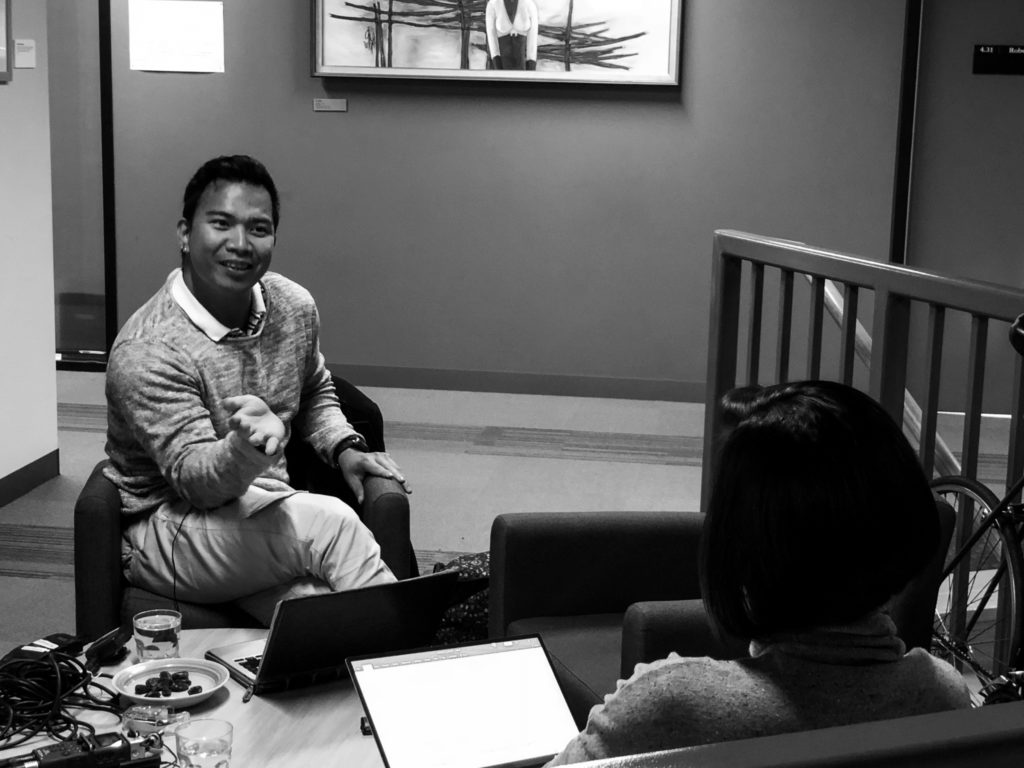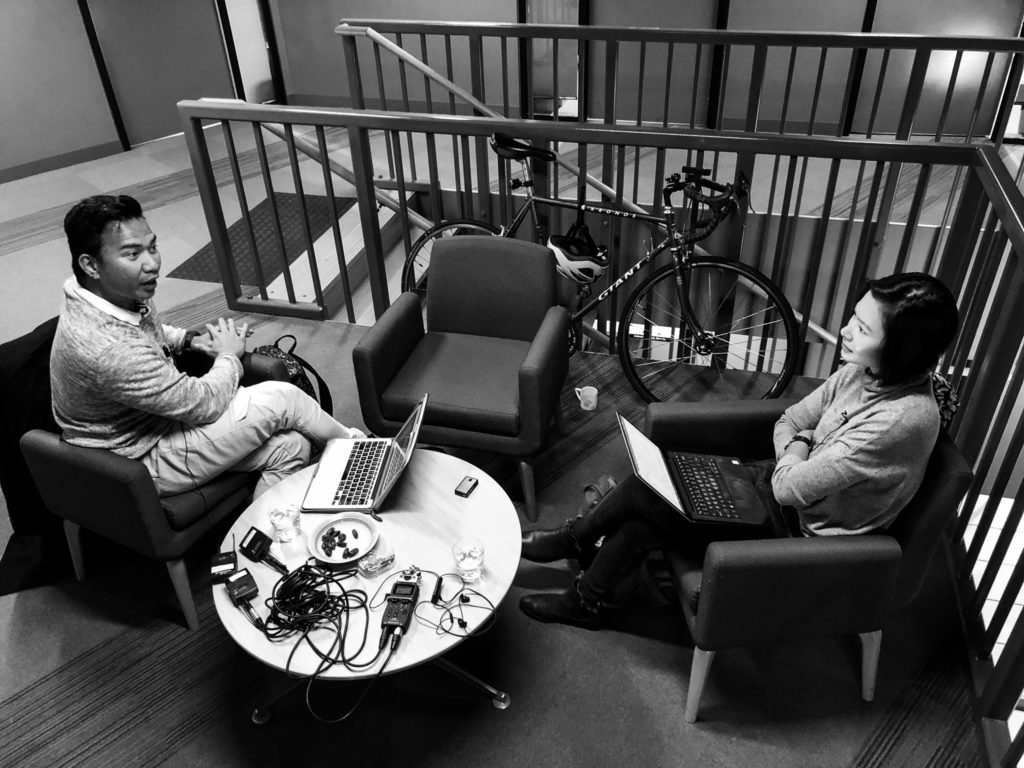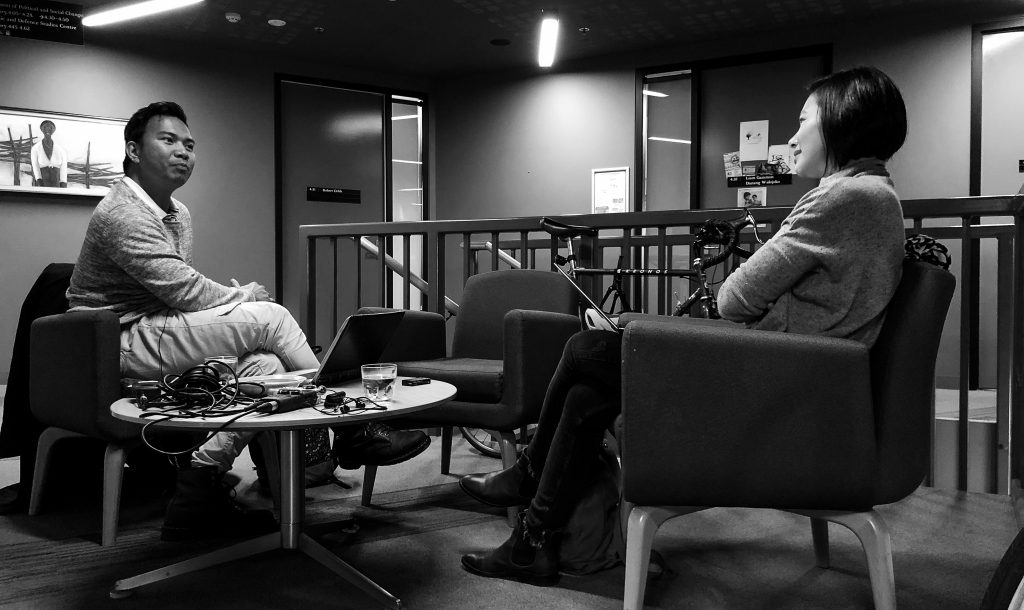Welcome to Part 5 of our special series of podcasts that take a look a The Philippines beyond the cliches. In this episode, New Mandala’s Philippines editor Dr Nicole Curato speaks with Yves Aquino about beauty standards in the Philippines. The transcript below was prepared by Bianca Ysabelle E. Franco from Ateneo de Manila University; note that it has been lightly edited for clarity and may at points differ from the recording.
NC: Joining us here at the headquarters of New Mandala at the ANU is Yves Aquino. So, Yves is a physician and a bioethicist currently based at the Philosophy Department of Macquarie University in Sydney. His work examines the ethics of surgical modifications among Asian women. And somehow, I managed to persuade him to swing by the capital to join us for a half hour conversation about beauty. So, Yves, welcome to Canberra.
Yves Aquino (YA): Thank you, Nicole for inviting me here. I’m so happy to be here.
NC: Alright. So, the stereotype we’re unpacking today is this: in the Philippines, to be beautiful is to look like Pia Wurtzbach. Now, for the uninitiated in the Philippine cultural landscape, Pia Wurtzbach is the winner of Miss Universe in 2015 for the Philippines. So, she is 5 feet 7 inches tall, has brown eyes, straight black hair, she has toned arms and a flat belly, she’s young, has perfect skin, perfect teeth, and she’s biracial. Her father is German and her mother is Filipina. And there’s an impression that to be beautiful in the Philippines means to look like her. So, Yves, does this make sense?
YA: That’s a very topical question. But whether she represents the ideal Filipino beauty, I think it’s a yes and no. Or at least not necessarily because we have to—if we want to understand Filipino beauty, we have to sort of review our historical—sort of our cultural history and geography. We are a post multi-colonial country with several invaders and probably we will have another one in the next few years. (laughs)
NC: (laughs)
YA: We also have migration of Chinese, Indians, and Arabs in the past, meaning we are a multi-ethnic group. We are also an archipelago, which creates physical, cultural, and linguistic borders within our own country. So, it means we have a broad range of what it means to be beautiful. But is she beautiful based on Filipino standards? I think definitely yes. And in a way, being a mixed race means she has, as we say, the Goldilocks of ethnic features. She does not look too Chinese or too Malay or native, she does not look too white, so she is just right. She’s somewhere in the middle at least in terms of skin tone and facial features. And I’m not sure if you remember, we have the Alamat of the Kayumanggi or the Legend of the Brown Skin. In that story, back in the day, we were—as kids, we were taught that when God was creating humans, the first batch was unsuccessful. It was uncooked. We call it in Tagalog hilaw. And that’s the white people.
NC: Because it’s pale.
YA: Yes. And then the second batch also did not work. It was overcooked or burnt. In Tagalog, we call it sunog. And that’s the black people. And then the third batch became successful. It’s what we call katamtaman or just right. So, those are the brown skinned people or the kayumanggi. And in a way, it’s sort of reflecting a colour pride to go against the colonial mentality that white is beautiful.
NC: Or racial superiority?
YA: In a way it is racial superiority as well.
NC: Because I remember this story in preschool. This is what they ingrained to younger kids saying that you have to be proud of your skin tone forgetting that the range of Philippine skin tones vary.
YA: Yeah, exactly. And of course, we have—as I’ve said—because as an archipelago, we have different skin tones for different regions as well. So, we have to take that into consideration. And third, she is beautiful insofar as beauty pageants are concerned. I think Filipinos are great in terms of categorising beauty. So, you have beautiful for marriage, you have beautiful for employment, you have beautiful for TV and film, acting, and you have beautiful for beauty pageants.
NC: Oh my god! Let’s unpack that. What does that mean?
YA: So, she’s beautiful because she’s quite tall. She is meant for beauty pageants and that’s what she represents. And in the Philippines, I think people sort of venerate and revere that kind of beauty, not necessarily envying it. Not a lot of people who find her beautiful want to be her. A lot of people, gay men and women look up to her as if she’s a goddess.
NC: Right.
YA: Unreachable, but beautiful.
NC: I think that’s interesting because in the previous podcast, we had Hannah Bulloch on the program and she’s an anthropologist and one of her—or part of her work talks about colonial mentality when it comes to the Filipino concept of identity and one of her arguments is how American lifestyles embodies, serve as reference points for ideals of affluence and beauty. Does that still hold? The American standard of beauty? The colonial mentality we get from—colonial tradition has become the standard for what beautiful looks like.
YA: That makes a lot of sense because it’s a combination of race and class superiority. If—as you’re familiar, when it comes to colonialism, a lot of times, the colonisers reinforce existing hierarchies. So, even before Spanish and American colonisation, we already have social hierarchies. We have the maharlika, the elites. And we have the working class, payak. And then you have the alipins, the slaves. And a lot of times, they are judged based on their skin colour. And so, when it comes to whiteness, it’s not just about Western features, it’s also about elite features. For the elite, they stay at home. They don’t till the lands, they don’t go fishing so, they don’t get dark skin tone. So, in a way, it’s a combination of both. Being white means being rich and being white also means being Americanised.
NC: And of course, I want to unpack the concept of biracial beauty. I remember in the Philippine pop culture scene, there has been a lot of debate about why can’t the Philippines claim space globally featuring the “real” Filipinos. And I’m doing air quotes here. The “real” Filipinos. And I remember when it comes to football, players like Phil and James Younghusband, who are also biracial, half British, half Filipino, are being criticised for not being “real” Filipinos. Or I think in the context of Australia, there has been an SBS feature about the most popular Australian you’ve never heard of which is—who’s Anne Curtis who has a million [9.7 million] followers on Instagram. So, I guess there’s this anxiety or tension within discussions in the Philippines of who are “real” Filipino looks like. So, how does your work speak to that?
YA: It’s entanglement of a lot of issues because especially when it comes to Filipino pride, it’s quite selective. So, for as long as something is positive, any amount of Filipino blood will be claimed by Filipinos. But we have to understand that Filipinos is also a heterogeneous population. Some would immediately sort of latch on to the Filipino-ness of some international celebrities but others would claim that they are not authentic Filipinos. So, there’s a combination of that. But a lot of these issues is really based on appearances, isn’t it? A lot of Filipino celebrities who are well-known worldwide who are not considered as beautiful, a lot of them are popular because of their talents. So, you have Manny Pacquiao, you have Lea Salonga, who I find very beautiful but she is far known more as a singer than obviously as a beauty contestant. She was never a beauty contestant. But in other cases, like Anne Curtis, for example, or the Azkal boys, it’s because of their appearance that they are being criticised. They are beautiful but they are not necessarily pure Filipinos. So, there’s a tension. Yes, we want them to sort of claim they’re being a Filipino but at the same time, we hold ourselves back because they don’t look like the rest of us.
NC: And how does this speak to the broader of Southeast and East Asia? You’ve examined notions of beauty in these contexts as well.
YA: So, there’s a shared sort of preference for whiteness that Filipinos sort of share with East Asia and Southeast Asia. And that’s still quite dominant. So, as I’ve said, it’s a combination of sort of class issue and sort of Western feature issue and Philippines is part of that sort of sphere.
NC: And does the colonial tradition have anything to do with it? Or has it been evolving a lot when it comes to the more mainstream Hollywood cultures?
YA: It’s a combination of both. This interesting thing about Filipinos—or at least the Philippines in comparison to say, South Korea, which was never colonised. It’s hard to distinguish them at this point because as you’ve said, the importation of Hollywood ideals of beauty is so dominating that we don’t know if it’s a factor of us just being part of the modern globalised industry or is it because of our history of being colonised? So, I think it’s a combination of both.
NC: Yes, rather iterative.
YA: Yes.

NC: And of course, there’s a political economy argument to be made here. And I’m sure you notice this that every time we go home to Manila, we see a lot of billboards that advertise laser liposuction for the arms, Thermage treatment to chisel the jaws, skin whitening, and even vaginal reconstruction. And advertisement is right there, a billboard is right there in one of the biggest highways in the Philippines. So, how big is the beauty and cosmetic industry in the Philippines?
YA: I don’t have the exact numbers but based on conversations with my colleagues in plastic surgery, it’s definitely growing. But we also have to thank, I guess Dr. Vicki Belo for allowing cosmetic surgery and cosmetic procedures to not only enter the mainstream, but to be visible. Because back in the day, there is a lot of stigma when it comes to plastic surgery. People don’t want to admit it, people don’t want any obvious, visible markers of surgery. But now, I think people are more open to discussing it. A lot of—I think a few celebrities have come out in admitting that they’ve had surgeries done on their faces or other body parts.
NC: Right. Of course, you are a physician yourself and you’re very much embedded in the medical community in the Philippines. And what you’re telling me is this: the rise of celebrity doctors really mainstreamed cosmetic surgery in the Philippines. So, it is really kind of a turning point when it comes to this industry. Would you call it an industry?
YA: It is an industry. But it’s also its own monster. Because any cosmetic service provider that advertises, they’re not usually part of the medical community or the medical specialty that they’re claiming to be. So, Dr. Vicki Belo is not part of the Philippine Dermatological Society or Philippine Plastic Surgery Society [Philippine Association of Plastic, Reconstructive & Aesthetic Surgeons, Inc.] because any member of those societies are not allowed to advertise. But as long as you are a doctor and you want to claim to be a cosmetic surgeon, no one is stopping you. So, we have to make a distinction and I don’t want to sort of betray my medical profession for that.
NC: Of course. And I think this is where your bioethics voice is very important. I read your piece published in the Theoretical Medicine and Bioethics Journal where you argued that surgical modifications, particularly “big eye” surgery among Asian women is pitched as a remedy to pathologise Asian features. So, if I may pull a quote from your article, you argued that “the combination of medical jargon and aesthetic references, employed by cosmetic surgeons have the tendency to conflate beauty and health” (p. 218). So, what does that mean?
YA: In my research, I make a distinction when it comes to forms of conflation. The first one is conflation based on the concepts. So, it’s a conceptual conflation when we use medical language to describe beauty concerns. In my Master of Research thesis, I did a text analysis of cosmetic surgery websites in Australia and South Korea. And what I found was the use of disabling language like deficiency, deformity, lack, excess. All those words that you actually find in describing pathological conditions in a lot of medical textbooks. So, that’s one at least on the conceptual level. Usually, in terms of Asian cosmetic surgery or Asian eyes, a lot of surgeons in websites describe Asian eyes as lacking of folds or sub-optimal or aesthetically deviant. So, it sounds scientific, objective, and to some extent, medical as well. The other type of conflation is more practical. So, that’s when you offer diagnostic evaluation that you usually use for medical conditions. It’s like using X-ray, using computers and algorithms to measure, you know, different proportions of the face. And the second part of that practical conflation is offering medical intervention as if they are “corrective” or restorative. So, in a way, that contributes to the idea that ugliness or sort of racial features are like deformities associated with injuries, disorders, or other kinds of diseases.
In terms of the second question, I think in the Philippines, we are still not as explicit. It’s not as similar to the medical framing that you find in the US, Australia, or even South Korea, where surgeries are extremely popular. I think our notion of beauty and ugliness in the Philippines are still more entangled with other social factors such as class and socioeconomic status, urban versus rural origins, and being a mixed race. So, if you look at skin whitening as an example, which is really popular in the Philippines, the way it’s marketed is not really about looking healthy. A couple of years ago, GlutaMax, it’s a very popular skin whitening product, had this marketing slogan that says Kutis Mayaman or the skin of the wealthy or the rich. It features the photo of Gretchen Barretto, a popular Filipina actress. And there were posters of that, a lot of those posters in the Philippines. I think in the Philippines, being a developing country, health still does not have a strong currency when it comes to beauty as much as it does in developed countries. So, as of the moment, marketing cosmetic procedures does not have to rely on it. The value of physical appearance based on relational and socioeconomic benefits, I think that’s enough to sell these services.

NC: But is there pushback as well? Because I think in the same way that Hollywood is trying to pluralise its concept of beauty, we’ve seen Vogue and Vanity Fair covers that feature different kinds of women from different kinds of backgrounds. Do we see a similar pushback in the Philippines?
YA: I think so. I’m not sure if you’ve heard of the scandal of a new telenovela in the Philippines.
NC: Right. Bagani.
YA: Bagani. So, that one, they tried to put on darker skin tone on the actors and a lot of Filipinos pushed back against that, saying that it just showed how a lot of our actors are still fair-skinned to the point that none of the actors that we have as of the moment can authentically portray a dark-skinned indigenous population. So, I think a lot of people are growing and stating that we should have more democratised notions of what is beautiful.
NC: And of course, we couldn’t possibly talk about notions of beauty without putting a gendered aspect here. And so far, I’m assuming that people who are prone to these stereotypes and pressures to look a certain way are women. And do you see similar patterns when it comes to men? Are there emerging cultural patterns that pressure men to look a certain way or conform to a particular standard of beauty as well?
YA: I think there is. Based on the recent survey by the International Society of Aesthetic Plastic Surgery, there is a growing number of male patients undergoing cosmetic surgery. But make no mistake, women are still 85% of consumers for cosmetic surgery. So, let’s not make the claim that it’s being democratised because it still disproportionately affects or involves women. But there is a growing number of procedures for men like hair replacement for baldness, penis enlargement, and also surgeries for gynecomastia. But what’s interesting is that a lot of feminists working in bioethics and cosmetic surgery find that a lot of male procedures are more accepted as medical procedures. They feel that appearance concerns of men are much more organic than women. Which is fairly interesting and it’s quite consistent with how—with the uneasy relationship of medicine and the female body.
NC: Can you unpack that a bit? Why is there an uneasy relationship?
YA: So, when it comes to hair loss, I think society is quick to accept that hair loss is not merely an aesthetic concern, that it also has to do with testosterone and biochemical factors. So, it sounds much more organic as opposed to female concerns about their nose or their breasts or their vagina. It sounds like society still deems that as purely about vanity. So, when I say medicine has an uneasy relationship with the female body, there’s a longstanding history in medicine where it’s the male body that is deemed as the normal body and the female body is a sort of deviance. The female body’s a failed body of a man. So, when you talk about vagina, it’s an organ that failed to develop as a penis. So, there’s that sort of problematic history when it comes to medical view of—medicine’s view of the female body. Which is interesting it’s being reflected in cosmetic surgery.
NC: Right, of course. And I think we also discussed earlier, or we touched on briefly earlier about the competing notions of beauty in the region and we also looked at East Asia when it comes to this. I’m particularly curious about the concept of the eye. Why of all features of the body is the eye considered most problematic or contentious especially in East Asia?
YA: Firstly, I think the general notion that the eyes are the windows to the soul still holds true. (laughs)
NC: Is that a medical claim? (laughs)
YA: I think it’s influential because when people talk to each other, eye contact is really important. But more importantly, it’s the eyes that are still the main subject of ridicule. So, a lot of Asians living in Western countries, they are called names such as chinky eyes or slanty eyes and people who are mocking them pull their eyes to the side to sort of mimic that Asian feature. So, in a way, because it’s a point of ridicule, it’s much easier for cosmetic surgeons to justify that, “See, there is an emotional suffering and emotional pain associated with this Asian feature. We have to do something about it. Let us offer surgical procedure to sort of relieve the suffering.” Whether or not that’s true, it’s still obviously up for debate.

NC: I read this in American Asian Studies on how the stereotype on the other hand for East Asians would they are the successful, good migrants who do well in school. So, in a way, there’s one stereotype of the good student who has oriental features versus the beautiful student who—that are very different things. Either you’re smart or your beautiful. So, does that stereotype still hold true today? Especially for diasporic communities in Western contexts?
YA: I think it’s different when it comes to the experiences of Asian women and Asian men. So, when it comes to Asian women, a lot of times they oscillate between exoticised and being deemed unattractive. So, being exoticised in the sense that they’re seen as beautiful in a very specific ethnic context. But when it comes to the stereotype of being successful, I think in a way that works for them, especially when it comes to corporate jobs where appearance can only be an advantage to some extent. You can’t be too beautiful. You can’t be distractingly beautiful. So, because they can be viewed as unattractive to some extent, that works to their advantage. I think it might be worse for men in some sense because Asian men are historically viewed as emasculated or asexual. So, they’re not masculine because of their fine features and a lot of times, even the eyes, it’s associated with being passive, with being at some point intellectually inferior. Because people say having a flat face looks like something who is not emotional. It does not register the kind of, you know, joy that you see in a lot of Western faces.
NC: Which sort of literature reinforce that? So, aside from fashion magazines of course.
YA: It has been studied in sociological research in the US and Australia. There’s this publication by Eugenia Kaw in the US, I think that was published in 1996 [1993], that looked into how cosmetic surgeons in the US justify surgical procedures for Asians. And that’s one of the claims. It’s that the Asian face appears to have this sort of association with behavioural and intellectual deviance.
NC: Yes. And of course, we started the podcast by talking about Pia Wurtzbach. So, I would be remiss not to raise the issue of beauty pageants and how the Philippines has always seen beauty pageants as a point of pride. And in a way, this is where the argument that the Philippines is more comparable to its Latin American neighbours rather than its Southeast Asian neighbours. Because we are neighbours to Latin America culturally albeit not geographically and perhaps the colonial tradition has something to do with it. So, what are your thoughts? Why are the beauty pageants such a big deal in the Philippines and why was it such as big deal that Thailand suddenly breaking in the scene as well?
YA: I think in the Philippines, we have a very uneasy relationship with physical appearance. I think we have to take into consideration that we are predominantly Catholic. So, bodily exposure has to be taken in a very specific context and beauty pageantry allows for a legitimate and sort of official venue for us to celebrate the body and you have the gown competition, you have the bathing suit competition, and you also have the question and answer. So, in a way, it’s a venue that allows us to celebrate beauty and physical attractiveness without the shame that we usually attach to it. So, that’s why it’s a big thing for us. But with the Thailand, I don’t think I have any specific opinion on that but it’s just unusual because—but it’s also surprising why—I think it’s highly overdue because in terms of cosmetic surgery, Thailand is still like one of the capitals in Southeast Asia.
NC: For medical tourism.
YA: Yeah, for medical tourism. So, I think it’s long overdue that they are breaking into the international beauty pageantry.
NC: And from the philosophy of ethics perspective, how can we judge beauty pageants? Because of course, there’s this standard feminist argument on how this reduces women to a meat market of bodies that are being judged. But of course, there’s this counter narrative, like what you mentioned, it’s a celebration of female body and sexuality and we should just stop being prudes about it. So, what are your thoughts on this from the ethics perspective?
YA: From the ethics perspective, I think in the Philippines, it’s not as apparent but if you look at Latin America, including Brazil, Venezuela, and Colombia, because of beauty pageantry, it increases the popularity—not even popularity, but the need for cosmetic surgery. Because for a lot of Latin American countries, which are still developing countries, a lot of times, beauty pageantry is the way out. It’s the way for economic success. So, for these countries more and more, beauty is being associated with health. It’s being associated with well-being. I think we are still far from this but in Latin American countries, they are viewing beauty pageant contestants as not only the ideal but the norm of beauty. So, even if you don’t want to enter contestants, it sometimes feels like you have to conform to those standards and it increases the burden for a lot of individuals to align with these standards which obviously increases the need for cosmetic surgery. So more and more, I think we are collapsing the distinction between what is necessary surgery and what is aesthetic surgery or surgery for the purposes of vanity.
NC: And part of it is also normalising surgery, cosmetic surgery for everyday Filipinos. Are there other stereotypes you wish to critically examine?
YA: I think I want to go back to that bit where we talked about us being predominantly Catholic. A lot of times, when people discuss beauty, it’s usually about race or about gender. But I think we have to take into consideration us being predominantly Catholic and the notion that I think a lot of Filipinos still hold the—or still suffer from the Madonna/Whore complex.
NC: Can you explain that?
YA: So, Madonna/Whore complex is this notion that there’s a specific kind of attractiveness that is appropriate for marriage and there’s one that is appropriate for sexuality. So, there’s the sexual beauty versus the virginal beauty. And that’s why I think a lot of Filipinos can categorise what kind of beauty they want to marry in and what kind of beauty they just want to view from afar, or they want to view from TV. And I think because of how—because of the shame that we sort of inherited from our Catholic tradition.
Despite Manila's push for peace, the NPA shows no signs of coming to the table.
The escalating violence of the New People’s Army in Mindanao
NC: And I think what I’m getting from you here is that you’re challenging, in a way, this notion that the concept of beauty is just imposed on people and people uncritically accept that standard of beauty. It’s very Frankfurt School in a way that we are conditioned to all want to look like Pia Wurtzbach or whichever kind of celebrity there is. What I’m getting from you is there are different contexts, have different demands on the particular sorts of appearances that legitimise your status in a particular community.
YA: That’s right. I think you have to give credit to Filipinos as well as thinking beings. That they do manage to idolise certain beauty without necessary being bogged down by it. A lot of Filipinos still have to live the day to day life. They have to work, they have to deal with the traffic, they have to deal with relationships, and they’re not always preoccupied with thinking with beauty.
NC: And I guess the same is true when we talk about expectations with women. As you mentioned earlier, there is expectation of the decent woman, the kind of woman that can marry into a decent family. So, those traditional structures are very much present but on the other hand, there is also a space to something more experimental like in the arts and culture, where women can express sexualities in different ways. Are we headed towards that direction? Especially—sorry, I have to bring it up—especially in a context of a sexist president. Where does this leave the politics of appearances in what seems to be an openly misogynistic society?
YA: The thing about misogynism in the Philippines, discounting our current president, it’s a bit tricky. It’s hidden in a lot of ways. It’s not as apparent as it is in Western Countries because female opportunities are quite present when it comes to education, when it comes to employment, even when it comes to politics. We have a lot of female politicians. So, the misogyny is not as direct. So, in a way, women are allowed to be beautiful, are allowed to be sexual to some extent. But I think it’s changing because obviously because of internet. And a lot of people are travelling outside the country more and more, bringing with them the cultural and the aesthetic ideals they encounter in different countries. And I think with the importation of films not only from the West but also from Asia, we have a lot of Korean telenovelas. Now, we have Chinese media coming in as well. So, I think it’s expanding, our notion of beautiful, our notion of ways to express what it means to be beautiful in the Philippines. So, I think we are in a constant flux.
NC: Right. And I think that’s worth celebrating to a certain extent. Well, we’ve come to the end of the program. I guess in summary, Yves, can you help us make sense of this statement: In the Philippines, to be beautiful is to look like Pia Wurtzbach. To what extent does that statement make sense?
YA: I think it means that for Filipinos, our beauty ideal is both outwards and outward-looking. That is, we focus on the superficial and we constantly seek external, even international validation.
NC: Alright. Well, thank you for joining us, Yves! And thanks to all our listeners for tuning in the first season of our podcast. Till next time.
 Facebook
Facebook  Twitter
Twitter  Soundcloud
Soundcloud  Youtube
Youtube  Rss
Rss 



